Bear in Mind the Beaver
By Amy Nelson
In the U.S., no animal is more universally associated with forest fire prevention than the iconic Smokey Bear. Created by the USDA Forest Service and the War Advertising Council in 1944, two years after Japanese submarines surfaced fired shells that exploded near California’s Los Padres National Forest, Smokey and his message of forest fire prevention resonated with Americans eager to do their part to protect the nation. Posters featuring Smokey Bear were adorned with slogans like “You can stop this shameful waste!” and “Only you can prevent the madness!”
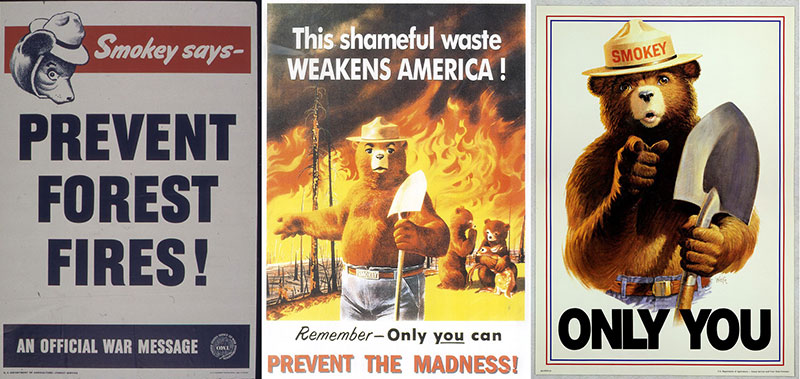
Decades later, however, we know that Smokey’s interpretation of fire as a shameful waste was more than a little misguided. We now know that a strategy of all-out fire prevention and suppression actually helped create conditions for the megafires of today. When it comes to a more balanced approach to fire management in the forest, perhaps we ought to be lauding another critter: the Beaver.
The beaver is often referred to as one of Earth’s first ecological engineers. For thousands of years, before they were nearly extirpated in the late 19th century as a result of our fondness for fur hats and coats, beavers sculpted the stream valleys, waters, and wetlands of North America, Europe, and Asia. In building their dams, beavers naturally achieve many of same conditions sought by conservation and restoration practitioners: raised water tables, reconnected and expanded floodplains, increased base flows and hyporheic exchange, improved water quality, and enhanced habitat complexity and diversity.
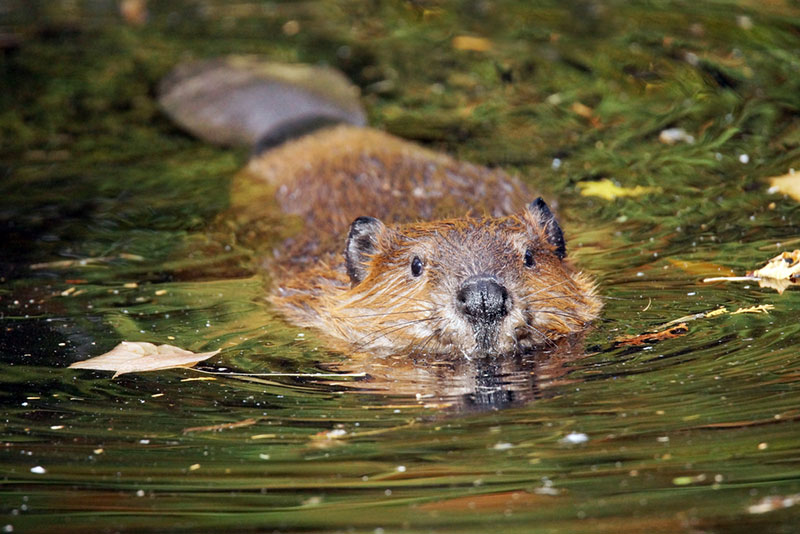
The impact of the Eurasian (Castor fiber) and North American beaver (Castor canadensis) on other animals and plants is so profound it is now considered a keystone species. [Leaf Litter devoted an entire issue to the role of beaver in ecology back in 2018]. One animal in particular reaps a heap of benefits from the ecosystem services provided by beavers: Homo sapiens. The first attempt to quantify the value of those services was published in Mammal Review in 2020 (Thompson et al., 2020), and according to that study, beaver provide $208 million (USD) worth of greenhouse gas sequestration and habitat and biodiversity provision every year.
Aware of the benefits brought by beaver activity, many land managers and ecological restoration practitioners have turned to beaver-inspired strategies to protect and restore ecosystems. When circumstances allow, this relatively lower cost, lower-tech, and lower-impact approach can be an attractive option for reconnecting floodplains and regenerating ecosystem processes. But what many may not know is that beaver activity and beaver-based restoration solutions may also aid in protecting communities—both human and otherwise—from the devastating impacts of modern megafires. The economic value of that service has yet to be quantified, but as wildfires continue to increase in size and severity, one can imagine a very large figure.
A growing body of science is showing that beaver activity helps protect sensitive ecosystems while allowing fire to occur. By creating very wet floodplains and enabling landscapes to hold more water, beavers create natural fire breaks, provide refuge for wildlife during and after wildland fires, and aid in post-fire ecosystem recovery.
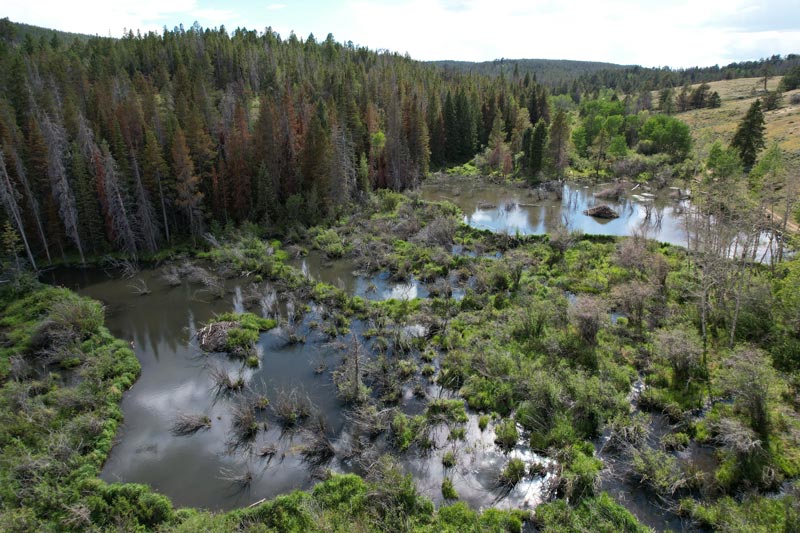
“If all of our rivers were super healthy and resilient, beavers might not be quite as important,” said Dr. Emily Fairfax, an Assistant Professor of Environmental Science and Resource Management at California State University Channel Islands who has devoted her career to studying beaver. “But given how degraded many rivers are these days, having beavers around provides very significant fire protection.”
Fairfax is one of the scientists behind some of the newest research on beavers and wildfire protection, and she has the data to back up her claims. In a study entitled “Smokey the Beaver,” which appeared in the journal Ecological Applications in 2020, Fairfax and her colleague Andrew Whittle found that riparian corridors with beaver dams were relatively unaffected by wildfire compared to similar riparian corridors without beaver dams.
Fairfax and Whittle examined five large wildfires that occurred in the Western U.S. between 2000 and 2018. The fires varied in severity and dominant landcover settings, but they all had one thing in common: beaver activity in the landscape. Using satellite imagery and vegetation health metrics derived from that imagery (Normalized Difference Vegetation Index – NDVI), Fairfax and Whittle compared areas within each wildfire scar with and without beaver activity.
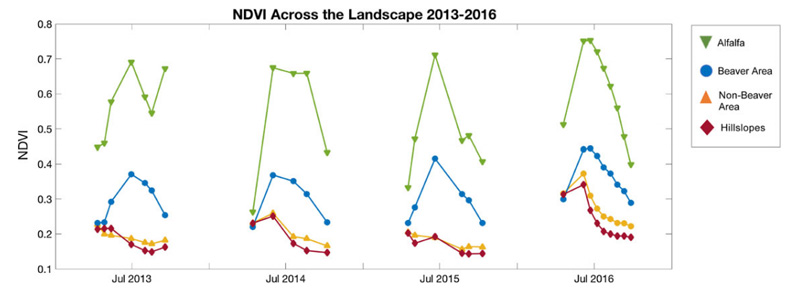
“I saw that as each fire moved through the landscape, the patches that had beaver dams in them were staying visibly green,” said Fairfax. “In terms of satellite accessed vegetation health metrics, they were productive, even when fire was burning all around them.”
I saw that as each fire moved through the landscape, the patches that had beaver dams in them were staying visibly green.
This was not the case with river corridors— even those with the same topography and ecology—in which there were no beaver. “They burned a lot more,” said Fairfax. In fact, Fairfax and Whittle found the beaver-less areas to be more than three times more affected by fire than areas with beaver.
Their study also showed that beaver activity plays a significant role in riparian vegetation fire resistance and refugia creation, particularly for species that are unable to physically escape wildfire, such as fish, amphibians, reptiles, small mammals, and some ungulates.
In another study, one that Fairfax is currently conducting with one of her students at a burn site in Atascadero, California, 74 different species were documented visiting beaver ponds over the last two years. “And that’s just terrestrial species,” adds Fairfax. “We have not even looked at fish or amphibians.”
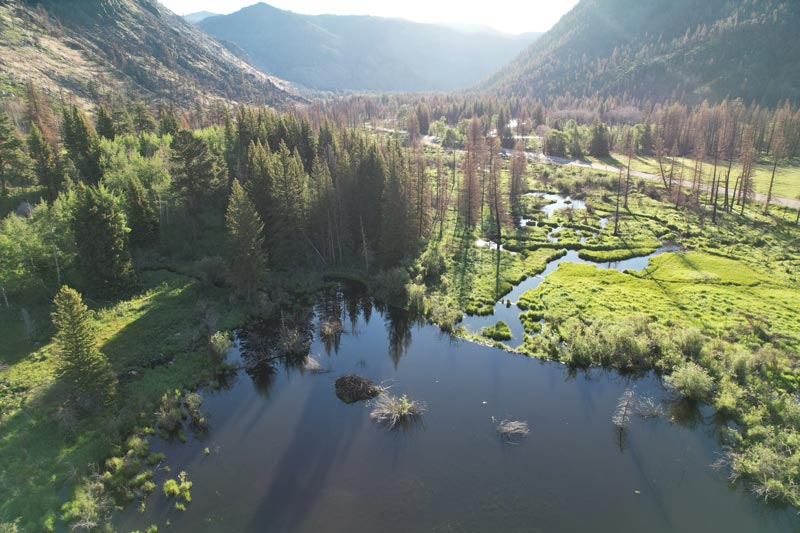
Serving as natural fire breaks and providing refugia in a burnt or burning landscape are just two of the fire-related ecosystem services resulting from beaver activity. Another important service comes before the fire.
Since most of the water in beaver complexes is actually underground, another benefit of beaver activity is their ability to keep floodplains wet and fire-resistant—even through droughts. Fairfax explains:
“When beavers build dams, that begins to slow the water down. While it’s challenging for water to get through the dam, they are not impermeable structures. As pressure builds up on the dam, water will try to route around, over, and under it. When it goes around and under, it gets pushed into the soil, and once water goes into the soil, it’s on a lot slower flow path and it is accessible to plant roots.
Meanwhile, the beavers are digging canals from their pond out into the floodplain. Beavers are awkward on land, but they are very agile in water, so they use these canals to access food and building materials. When they do that, it is like running irrigation canals through the landscape. So now there are even more ways for water to spread out onto the floodplain during every single wet period. Then, when you have a dry period, you have all this water stored in the soil. That water could have been stored there six months ago, and it’s still making its way downstream, nice and slowly, buffering everything in its way against that drought effect.”
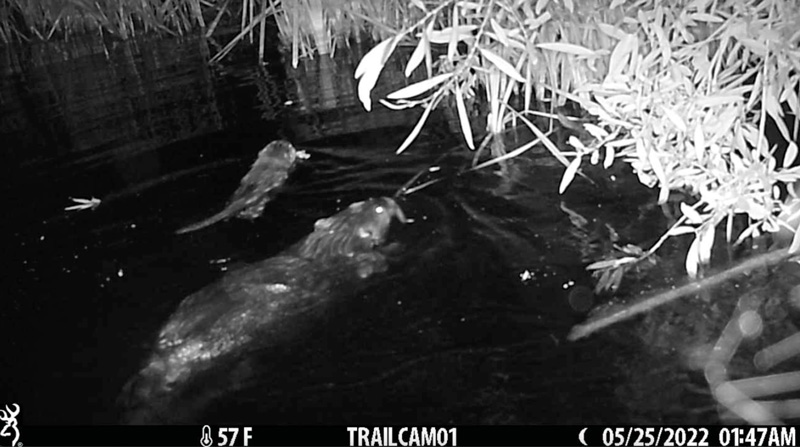
Another fire-related benefit of beaver activity comes after the fire.
“A fire in a landscape destabilizes and adds a lot of ash to the soil,” explained Fairfax, “and that gets into the waterways.” According to Fairfax, emergency post-fire Beaver Dam Analogs (BDA) installed downstream of burned areas of Colorado and Oregon have been successful in trapping sediment, ash, and other pollutants. “There were fish hanging out in water downstream of the BDAs,” she said. “Whereas in streams that didn’t have those structures, the fish are all dead.”
Last summer, wildfire burned through one of Fairfax’s research sites in California—one featuring several BDAs. While she has no concrete data on the impact of those BDAs, anecdotal reports indicate that they are providing patches of fire refugia. Fairfax acknowledges that the patches created by the BDAs are not as large as those that are created by actual beavers. “It’s better than nothing,” she said, “and it definitely is a step towards attracting beavers back to those watersheds so that we can get larger and larger benefits in the future.”
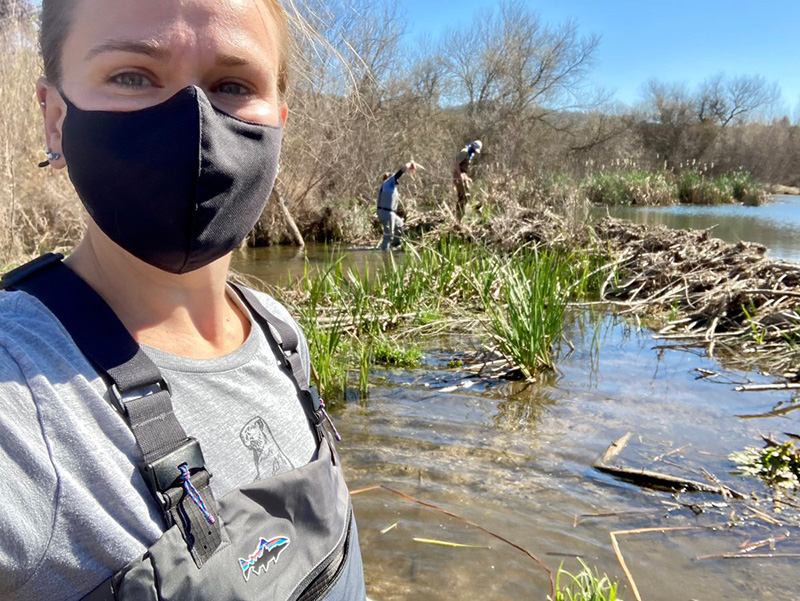
One type of place that could certainly use some natural fire breaks is the wildland urban interface, areas where human development intersects with undeveloped wildland or vegetative fuels. This includes more than 60,000 American communities, according to the U.S. Fire Administration.
“Creeks run through a lot of these communities, and many of them are in terrible condition,” said Fairfax. “Any sort of restoration we can do there is going to improve community fire resiliency.” While beavers and beaver-based restoration may not be feasible in areas with steep hill slopes or no river networks, Fairfax would like to see applied wherever it is appropriate- for the ecological and fire prevention benefits. “Even if we can slow down a fire by a couple of hours,” she said, “that can be the difference between getting firefighting equipment and people on site or not.”
As recently as April of this year, Fairfax and her colleague Chris Jordan of NOAA Fisheries’ Northwest Fisheries Science Center, published a study showing that even as global temperatures rise, beavers create cycles of increasing riverscape resilience.
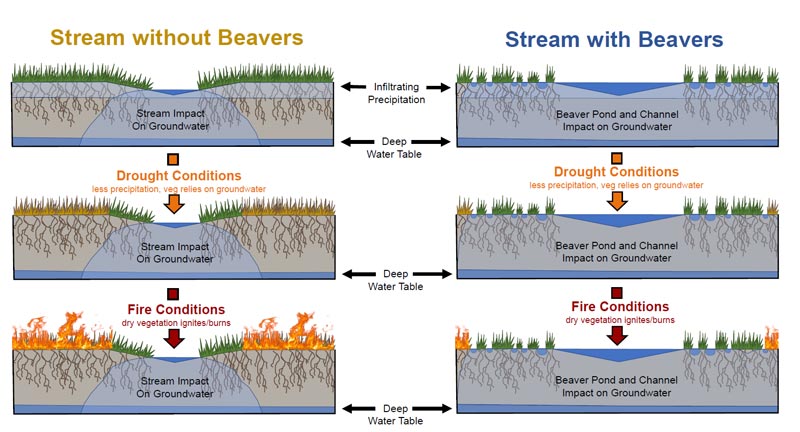
But reintroducing beaver, designing with the intent to attract beaver, or using beaver-inspired stream and river restoration design techniques is not always a slam dunk. Among the key challenges, according to Fairfax and other experts featured in Leaf Litter, are education and communication. Because the beaver is, technically, a rodent, many people perceive of the animal as a pest.
“There are a lot of myths around beavers still that people cling to,” said Fairfax. Top among such myths, she says, is the belief that beavers breed quickly, and that if one is brought into a landscape, there will soon be thousands. “Beavers have one litter of kits per year max,” said Fairfax. “That means one to six babies—only half of which make it to adulthood.”
Other myths include beliefs that beaver eat fish (they are obligate vegetarians) and that they will eat and kill every tree in sight (they will not; many of the beaver’s favorite foods grow back after being chewed, which can make them more productive).
When it comes to dispelling these myths and informing people about the many benefits beavers bring to ecosystems and the human communities within them, Fairfax is certainly doing her part.
“In my research, I see that beavers can make a meaningful impact and provide very real drought and fire mitigation benefits,” said Fairfax.
“We have a very short window within which to address climate change,” she said. “When I have science and data showing part of a potential solution, I don’t want to sit around and wait for people to come to the conclusion on their own,” she said. “I want to be loud and clear about what the science does and does not show and what we still need to understand, because like with any climate solution, we’ve got to really act now.”
When I have science and data showing part of a potential solution, I don’t want to sit around and wait for people to come to the conclusion on their own.
Fairfax is certainly doing her part when it comes to publicizing the benefits of beaver activity to ecosystems and human communities. In addition to publishing scientific papers and speaking at conferences, she actively shares information in publicly digestible formats via social and mainstream media. This past July, an op-ed written by Fairfax and Jordan, appeared in the Los Angeles Times and was picked up by several other publications, including the Boston Herald. Fairfax has even created a compelling stop-motion animation which, in less than one minute, communicates the power of beavers in creating fire-resistant places.
“There’s only so much that I can do as a scientist or academic to share information with different communities,” she said. “If you learn about beavers and you think, ‘This is awesome,’ go tell your friends and family! Let that information percolate out into the broader community.”
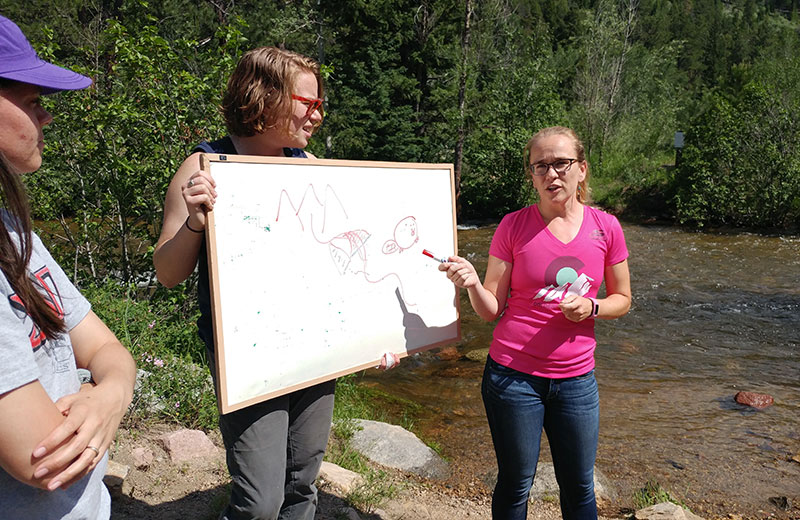
According to Fairfax, most people who now appreciate beaver activity as a plus for community resilience do so through the lens of flood mitigation. But with increasing attention to climate change and growing concern about drought and wildfire, this is shifting. “In North America and Europe,” she said, “we are starting to see a lot of rewilding efforts that are not only bringing beaver back to restore landscapes, but also to help build climate resiliency.”
But beaver-inspired ecological restoration is by no means a panacea for the ills of environmental degradation, or the threats posed by climate change. And when it comes to wildfire protection/prevention, Fairfax acknowledges that there is still much to learn about the practice.
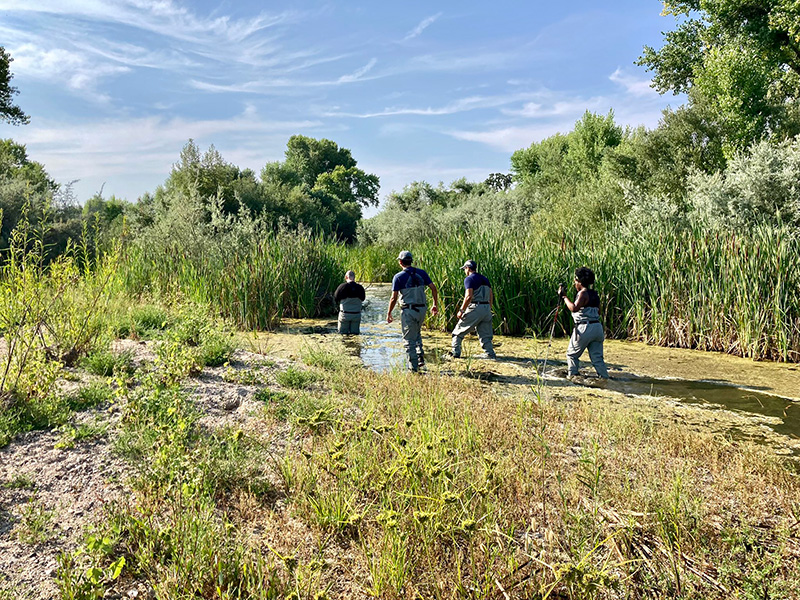
“We have a lot of information about how beavers affect the landscape, we know where fire risks are most extreme, and we know where we have the most potential for human conflict,” she said. “I want to really just knit all those models together.”
Doing so, she said, would enable researchers and practitioners to model different restoration scenarios and analyze the potential impact on ecology, fire behavior, and protection of human communities.
Of the 30 genera, multiple subspecies, and hundreds of millions of beavers that once carved the floodplains of North America, Europe and Asia, only one genus (Castor), two species (Castor canadensis and Castor fiber), and an estimated population of 10-15 million remain.
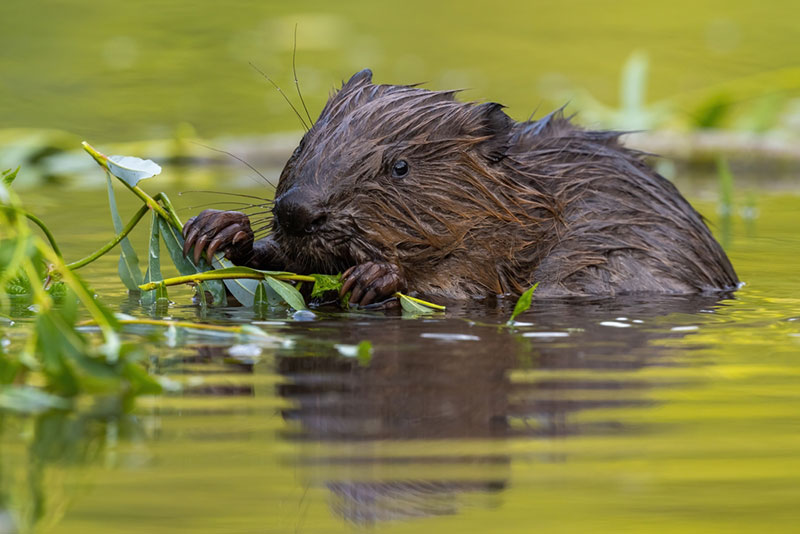
It is tempting to contemplate a world devoid of human folly. One in which the whims of fashion did not lead to the disappearance of so many of Earth’s early ecological engineers and floodplain managers. Or one where fear, colonialism, racism, and a lack of knowledge did not lead to the cessation of cultural burning and a century of all-out fire suppression. But alas, here we are.
Things are changing, however. Beaver populations are increasing, as acknowledgement of Indigenous wisdom and awareness of need for fire on the landscape. As all of this knowledge is coming to light, the gifts of the beaver are being illuminated. So while Smokey Bear’s warnings of caution may endure in the context of campfires, it is clear that when it comes to forest fire management, there is a new icon in town.
